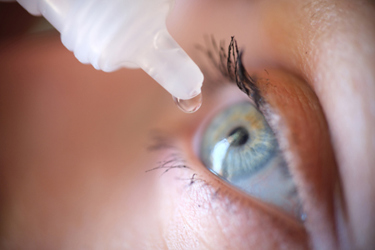Eying Up The Era Of Topical Biologics

By Matthew Pillar, Editor, Bioprocess Online

Having emerged from stealth mode at the top of this year, Claris Bio’s phase 1/2 clinical trial in patients with Stage 2 or 3 Neurotrophic Keratitis (NK) is already well underway. It’s an exciting story not just because it’s playing out quickly, but because Claris’ candidate is breaking new ground in the development of topically administered biologic therapies.
Founding CEO Clarke Atwell admits the company had a pretty sizable head start.
While conducting research on mesenchymal stem cells (MSCs) at the Massachusetts Eye and Ear Infirmary (MEEI), scientific cofounders Dr. Reza Dana, MD, MSc, MPH and Dr. Sunil Chauhan, DVM, PhD identified potential therapeutic benefits of a human recombinant hepatocyte growth factor (HGF) in corneal diseases. Their findings, demonstrated in multiple in vitro, in vivo, and ex vivo models, were well established by the time Atwell met with them in 2018.

When he met them in 2018, to Atwell’s surprise and delight, he recognized that Drs. Dana and Chauhan had already laid some the groundwork for a feasible IND package.
“They were seeing a salubrious effect from the cells administered to the surface of the eye,” explains Atwell, “but they realized that putting cells on the surface of the eye, from a dosing and regulatory perspective, would be very challenging from a CMC standpoint.”
Drs. Dana and Chauhan decided to simplify. They analyzed the secretome of the cells, and one-by-one, started knocking out the proteins that were being expressed. “It was when they knocked out HGF (hepatocyte growth factor) that the effects of the cells went away,” says Atwell. “That was their ‘aha’ moment.”
Atwell says the Harvard duo of doctors had also put considerable effort into understanding the mechanism of action (MOA) that resulted in their deleted Hepatocyte Growth Factor’s (dHGF) salubrious effect on the cornea. It’s no secret that MOA is often a black box. As Atwell puts it, “…there’s typically a lot of hand waving on MOA in package inserts. There’s not usually a lot of certainty there.”
The two Harvard scientists had positive animal model data on HGF, were able to replicate that data, and had a good handle on its MOA. A solid foundation was in place for a topically administered biologic in ophthalmology. What biotech entrepreneur wouldn’t want to step up to the plate and take a swing?
TESTING HGF IN OPTHALMOLOGY AT SCALE
Atwell reached out to Thomas Dyrberg at Novo Holdings, who showed interest. Kenneth Harrison, PhD, who’s now a Claris board member, put a “SAFE” debt vehicle in place; Novo would fund work to determine whether Dana and Chauhan’s work could be replicated at scale. If it could, the path to a series A would be paved. If not, no harm, no foul, no debt.
The team at the seedling company that would grow into Claris sent two models, a bacterial lipopolysaccharide injury model and a physical injury model, to a CRO in North Carolina. The CRO ran the models in 10 mice per group, testing for healing, prevention of scarring, and reductions to pre-existing scars. “If we hit our benchmarks, the Series A would initiate.”
Those benchmarks were met, and in April, 2020, the Series A closed. Novo and Mass General Brigham Ventures lead the raise, with RA Capital following close behind.
For its proof-of-concept trial, the team’s scientific advisory board advised that neurotrophic keratitis (NK), a degenerative corneal disease caused by impairment of corneal sensory innervation.
NK affects nerve endings in the cornea, which is more densely innervated than any other part of the human body. These nerves serve a sensory function, and they also serve a supportive function to epithelial cells; if they’re damaged, so is the epithelium. The epithelium starts to erode, resulting in a persistent epithelial defect that won’t heal. That, in turn, leads to ulceration and perforation of the cornea.
“Our therapy decreases inflammation, which creates an environment for wound healing, and it accelerates wound healing through the proliferation cells,” says Atwell. “It does these in an ordered fashion, which lends itself to the treatment of NK.”
After 4 months of formulation work, the team conducted a multi-species toxicology study, put together the largest IND file its veteran members had ever seen, and engaged the FDA.
CLINICAL TRIALS SOON UNDERWAY
The Agency determined that the safety of the team’s molecule, based on its own clinical data and its GLP tox studies, was such that it wouldn’t be subject to a standalone Phase 1 trial. Instead, Atwell and his team initiated a randomized control trial against vehicle.
For that trial, Wiley Chambers, M.D., director of the FDA’s Office of Specialty Medicine - Division of Ophthalmology (DO), agreed that if the team’s first 12 patients showed no drug related adverse events, it could continue enrollment. As such, enrollment in that trial is nearing completion.
Always a step ahead, the soon-to-be Claris team then asked the Agency for guidance on its next trial. After review of the team’s trial design and statistical analysis plan (SAP), the FDA indicated that its next trial would be pivotal. With that light shed, Atwell’s team revised the SAP for the trial it’s currently enrolling for, presented the update to the Agency, and received confirmation that it would in fact be considered pivotal. “In effect, we’ve initiated a Phase 1/Phase 2 pivotal trial,” says Atwell, “Which is something I haven’t seen before.”
Around the middle half of this year, Claris will already have topline data from that trial. “We think of ourselves as a biotech moving at dotcom speed,” says Atwell.
PIONEERING TOPICAL BIOLOGICS
The API for Claris’ drug is sourced from its Japanese partner company, Kringle Pharma, and the drug itself, dubbed CSB-001, is formulated at Siegfried Holding in Irvine, CA and self-administered from a ready-for use, sterile multi-droptainer. It’s a traditional biologic produced in CHO cells, purified and polished as any biologic would be. Claris has found dHGF stable for three years at refrigeration temperatures and three months at room temperature. The specially-designed droptainer for CSB-001 is administered from uses a filtration cap to maintain the therapy’s sterility without preservatives, which would not only add cost to the product, but can also inhibit healing.
Now, there is already an FDA-approved therapy for patients with NK. It, too, is a self-administered drug, marketed by the Italian company Dompé. The drug is called Oxervate, and its active ingredient is cenegermin, a recombinant form of human nerve growth factor (NGF).
Atwell calls the development of that drug groundbreaking, which involved Rita Levi-Montalcini, the Nobel Prize winner who first isolated NGF.
There is a “but.” The median age of NK sufferers, who number around 130,000 with about 30,000 new diagnoses annually, is 65 years. Oxervate’s self-administration involves a 17-step at-home formulation process, six times per day over an 8-week period. It’s Dompé’s first approved product, and it works, which is why it’s expected to reach $1B in sales in 2024 despite just being launched in 2019.
Still, a 17-step at-home formulation process is asking a lot of any patient, much less a largely elderly patient population. It requires extensive training by physicians before it can be administered, and those physicians largely acknowledge that adherence is difficult, at best. By contrast, while its dosing schedule is yet to be determined, Claris will test its pre-formulated candidate in 4x and 2x daily doses in its clinical trials. Claris also believes the anti-inflammatory properties of its candidate give it a safety advantage; Oxervate is pro-inflammatory, which can cause pain and irritation.
Still, Atwell acknowledges that Oxervate paved the way for topically administered biologics in ophthalmology. The standard delivery of biologics in ocular indications has been parenteral administration to the back of the eye.
NEXT STEPS FOR CLARIS BIO
Moving forward, Claris hopes to change the ophthalmology biologic drug paradigm well beyond the NK patient population. It’s begun an open-label study of CSB-001 in corneal scarring, where Atwell is feeling confident the drug will demonstrate effect. The company is also kicking off an open-label study in Limbal Stem Cell Deficiency.
As for its NK study, the company’s intent is to continue its aggressive pace, and the commercial pieces of its puzzle are already falling into place. “We have the API supply, we have the manufacturing capacity to support registrational batches and produce the drug at scale, and we can field a sales force,” says Atwell. “I think $70 million gets us to approval and another $50 million to profitability, and we already have very large investors to support our Series B. From there, maybe we think about an IPO. We're building this company as though we're going to take it all the way to the end and commercialize this product,” he says. “Like a house flipper, there came a point where we needed to decide whether we’d live in the house we bought or flip it. And I think we’ll live in the house.”
Learn more about Claris at clarisbio.com.
